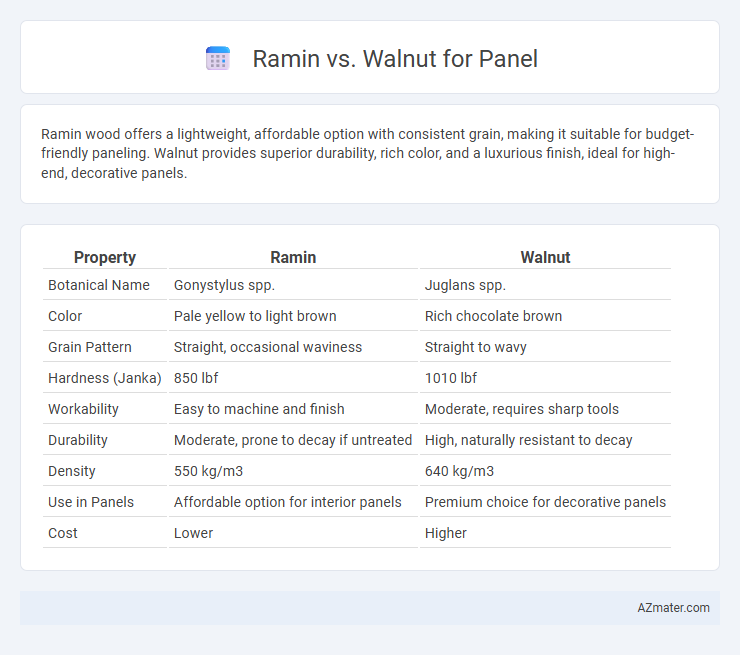Ramin wood offers a lightweight, affordable option with consistent grain, making it suitable for budget-friendly paneling. Walnut provides superior durability, rich color, and a luxurious finish, ideal for high-end, decorative panels.
Table of Comparison
| Property | Ramin | Walnut |
|---|---|---|
| Botanical Name | Gonystylus spp. | Juglans spp. |
| Color | Pale yellow to light brown | Rich chocolate brown |
| Grain Pattern | Straight, occasional waviness | Straight to wavy |
| Hardness (Janka) | 850 lbf | 1010 lbf |
| Workability | Easy to machine and finish | Moderate, requires sharp tools |
| Durability | Moderate, prone to decay if untreated | High, naturally resistant to decay |
| Density | 550 kg/m3 | 640 kg/m3 |
| Use in Panels | Affordable option for interior panels | Premium choice for decorative panels |
| Cost | Lower | Higher |
Introduction to Ramin and Walnut Wood
Ramin wood, harvested from the Shorea species primarily found in Southeast Asia, is prized for its lightweight, pale color, and smooth texture, making it ideal for interior paneling and detailed woodwork. Walnut, derived from Juglans trees, is renowned for its rich, dark brown hues and robust grain patterns, offering durability and a luxurious aesthetic favored in high-end furniture and panel panels. Both woods present distinctive qualities--Ramin's ease of machining suits intricate designs while Walnut's strength and elegance serve premium applications.
Botanical Origins and Distribution
Ramin wood originates from the genus *Gonystylus*, primarily found in the tropical rainforests of Southeast Asia, especially Indonesia, Malaysia, and Brunei. Walnut, derived mainly from the genus *Juglans*, is native to temperate regions of the Northern Hemisphere, including North America, Europe, and parts of Asia. The geographical distribution of Ramin corresponds to humid, tropical climates, whereas Walnut thrives in cooler, temperate zones, affecting their availability and growth patterns for panel production.
Physical Appearance and Grain Patterns
Ramin wood features a pale yellow to light reddish-brown color with a uniform, fine texture that creates a smooth surface ideal for paneling, while walnut is distinguished by its rich chocolate to dark brown hues and striking contrast in its wide, wavy grain patterns. The subtle, straight grain of ramin offers a consistent and understated aesthetic, enhancing modern or minimalist designs, whereas walnut's intricate grain and occasional curls provide a luxurious, classic look that highlights natural beauty. Both woods are prized for their finishing properties, but walnut panels often become statement pieces due to their dramatic visual depth and color variation.
Hardness and Durability Comparison
Ramin wood exhibits a Janka hardness rating of approximately 930 lbf, making it moderately hard and suitable for interior panel applications requiring resistance to dents and wear. Walnut, with a Janka hardness of about 1010 lbf, offers slightly superior hardness and greater durability, enhancing its performance in high-traffic or heavy-use paneling. Both woods provide durability advantages, but walnut's tighter grain structure contributes to better impact resistance and long-term panel stability compared to ramin.
Workability and Machining Differences
Ramin wood offers superior workability with a fine, even texture and low grain complexity, making it easier to machine and shape compared to walnut. Walnut, known for its dense, coarse grain and natural oils, requires specialized tools and slows down machining due to its hardness and risk of burning. The choice between Ramin and Walnut for panels hinges on the need for ease of machining versus a richer aesthetic finish, as Ramin excels in smooth cutting and sanding, while Walnut demands precision and care during workability processes.
Color and Aesthetic Appeal
Ramin wood offers a pale ivory to light yellow hue with a smooth, fine grain that provides a subtle and clean aesthetic, making it ideal for minimalist panel designs. Walnut stands out for its rich, dark brown coloration with deep chocolate tones and a striking grain pattern, delivering a luxurious and warm appearance that enhances sophisticated interiors. The choice between Ramin and Walnut panels hinges on desired ambiance--Ramin for light, airy spaces and Walnut for bold, elegant statements.
Cost and Availability
Ramin wood is generally more expensive than walnut due to its limited availability primarily in Southeast Asia, whereas walnut enjoys wider availability in North America and Europe, making it more cost-effective for panel production. Walnut panels are favored for their consistent supply and moderate pricing, which suits large-scale manufacturing. Ramin's higher cost reflects its dense, fine-grained texture and niche market demand in premium panel applications.
Applications in Panel Making
Ramin wood offers a fine, even texture and pale yellow color, making it ideal for decorative panels and intricate carvings in furniture and interior design. Walnut, prized for its rich dark brown hues and durability, is commonly used in high-end paneling for cabinetry, wall treatments, and luxury furniture due to its strength and elegant grain patterns. Both woods provide distinct aesthetic and structural benefits, with Ramin favored for lightweight, delicate panels and Walnut chosen for robust, visually striking applications.
Environmental Impact and Sustainability
Ramin wood, sourced from Southeast Asian rainforests, faces significant deforestation concerns due to illegal logging and slow growth rates, making it less sustainable for panel production. Walnut, primarily harvested in temperate regions with regulated forestry practices, offers a more sustainable option with lower environmental impact and better forest management certifications. Choosing walnut panels supports reduced deforestation and promotes responsible resource use compared to the ecological strain caused by Ramin extraction.
Choosing Between Ramin and Walnut for Panels
Choosing between Ramin and Walnut for panels depends on factors like durability, aesthetics, and budget. Ramin is a lightweight, pale hardwood known for its smooth finish and resistance to wear, making it suitable for indoor paneling in moderate traffic areas. Walnut offers rich color variations and exceptional strength, ideal for high-end, decorative panels that require both elegance and lasting durability.

Infographic: Ramin vs Walnut for Panel
 azmater.com
azmater.com